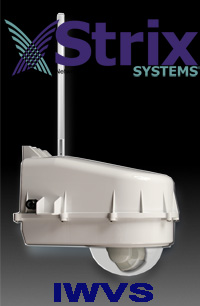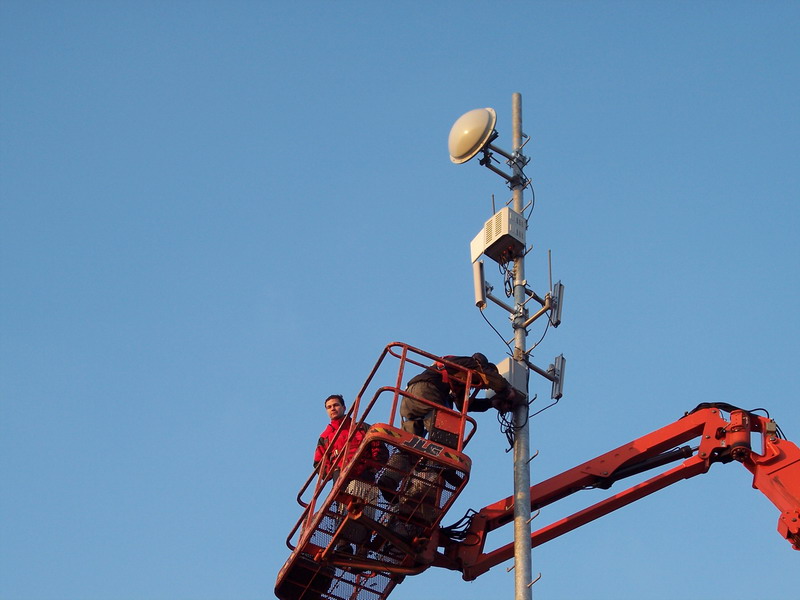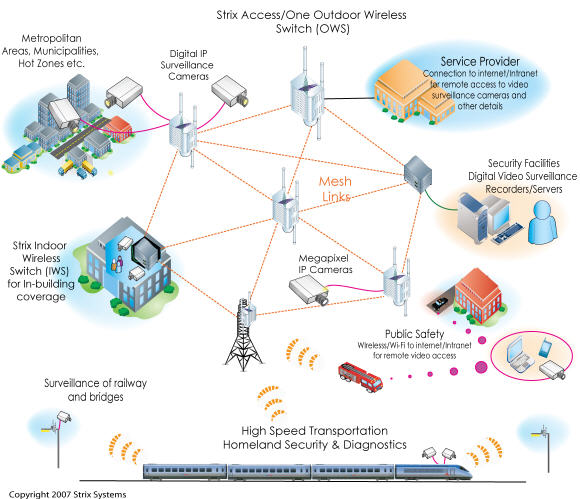|
High quality networked video surveillance requires
the greatest possible bandwidth, highest throughput, lowest latency and
scalability to meet the demands of today’s law enforcement, public
safety, federal government and large distributed enterprise.
 Today’s
IP networked video surveillance systems are capable of providing a far
greater resolution, flexibility, reliability and increased cost savings
in comparison to conventional analog video solutions. In the past,
wireless IP video surveillance has been viewed as an “adhoc” solution
with limited reliability. Wireless mesh networks are changing that
perception as more customers implement video surveillance over Strix
wireless mesh networks. Robust high performance, low latency and
multi-hop scalability enable range and coverage that wasn’t possible
only a few years ago. Today’s
IP networked video surveillance systems are capable of providing a far
greater resolution, flexibility, reliability and increased cost savings
in comparison to conventional analog video solutions. In the past,
wireless IP video surveillance has been viewed as an “adhoc” solution
with limited reliability. Wireless mesh networks are changing that
perception as more customers implement video surveillance over Strix
wireless mesh networks. Robust high performance, low latency and
multi-hop scalability enable range and coverage that wasn’t possible
only a few years ago.
The video
surveillance market is a billion dollar international industry.
According to ABI Research the video surveillance market is poised for
explosive growth to a remarkable $46 billion by 2013. A special 2007
report by iSuppli Corporation, the equipment market for video
surveillance cameras, embedded Digital Video Recorders (DVRs), and IP
video servers will grow to nearly $12B by 2011 and Frost and Sullivan
state in their recent 2007 report, "Network-based systems are expected
to completely replace analog and hybrid (analog video capture devices
with digital storage devices) systems by 2015-2016,”. At the same time
IMS Research indicates that by 2009 "analog recording systems are
forecast to account for less than 5% of the market".
 This
growth in the IP surveillance market is occurring as a result of the
expansion of existing network-based deployments and the architecting of
new completely networked digital surveillance systems both in the
public and private sector. The IP segments of the surveillance
equipment market is experiencing the fastest growth, as cameras
integrate IP and digital video recorders (DVRs) transition to networked
video recorders (NVRs). Additionally, growth in IP video surveillance
will also broaden the surveillance market, with new applications and
new market segments. This
growth in the IP surveillance market is occurring as a result of the
expansion of existing network-based deployments and the architecting of
new completely networked digital surveillance systems both in the
public and private sector. The IP segments of the surveillance
equipment market is experiencing the fastest growth, as cameras
integrate IP and digital video recorders (DVRs) transition to networked
video recorders (NVRs). Additionally, growth in IP video surveillance
will also broaden the surveillance market, with new applications and
new market segments.
The most
significant enabler for video surveillance market is the deployment of
wireless mesh networks. Strix wireless mesh networks are the catalyst
for large-scale distributed video surveillance deployments by
delivering the industry’s highest throughput, lowest latency, unmatched
flexibility, scalability and resilience for IP video cameras, servers
and video storage.
Strix wireless mesh
networks are deployed worldwide where robust “wireless like wired”
performance is a requirement and the delivering of mission critical
video surveillance, the highest quality voice and data applications are
essential. Strix Access/One® is the only wireless architecture
qualified by independent testing and real-life worldwide installations
where the result is the industry’s highest throughput, lowest latency,
the greatest range and coverage, unmatched scalability and carrier
class resilience.
“Prior to Strix, we had given up on the ability of wireless systems to handle the burdensome capacity, throughput, ongoing management, and overall network performance demands required to support multiple integrated real-time services on one platform,” said Thomas Norman, Executive Vice President of Protection Partners International. “With Strix, we can support up to 12 streaming video stations per radio across a multi-linear wireless mesh backbone, which is unthinkable with single-radio architectures. Not only does Strix’s multi-radio architecture provide the overall capacity we need, but the overall ease of deployment saved us both money and time, and the ongoing operation and management of the system is incredibly simple.”
"Old-school"
deployments utilize coax, expensive fiber multiplexers and distribution
amplifiers coexist with encoders and even category 5/6 Ethernet-like,
but proprietary, wiring. This method of directly cabling surveillance
devices is changing rapidly. Eliminating any dependence on wires,
removes a significant number of obstacles and the excessive costs
associated with deploying video cameras where it was previously
impractical or impossible. Cameras and video servers can now be placed
virtually anywhere within range of the wireless mesh network
infrastructure and is used to supplement existing analog CCTV systems.
And an increasing number of organizations are finding the advantages of
networked video so compelling, they are replacing their legacy analog
CCTV infrastructure entirely.
The Distributed Video Surveillance Network
Strix
Systems wireless mesh networks are making large-scale and strategic
IP-based video surveillance possible. Whether used for government,
municipal, public safety or enterprise security, video surveillance is
a critical application which, until now, has been restricted to wires,
cable, fiber and unreliable wireless solutions and expensive to deploy.

Distributed
IP video surveillance provides the ability to view, share and
‘distribute’ video, statisticaland integrate information with other
application and systems such as the access control andintrusion
detection systems without the need for centralized servers and removes
the risk of single point of failure. Strix Systems makes a fully
distributed IP surveillance system possible for cameras, video servers,
storage clusters, custom applications and remote viewing to be located
in any location, even geographically. Networked video surveillance
integrated with other security applications such as alarm systems in
geographically remote areas enables an increase in effectiveness of
security operations personnel and cuts the expense of responding to
false alarms. This unification helps to reduce the false alarm rates,
which exceeds 90 percent in most organizations.
Benefits of IP Surveillance systems
|
- Scalable installations that can scale with your requirements
- Integrate with other security systems at geographically separate locations.
- Optimization of video streams resulting in less storage space compared to previous solutions.
- Video streams distributed to multiple locations.
- Wider distribution and remote access anywhere, anytime.
- Easy viewing of live and multiple video images on multiple computer and handheld devices.
- Quick and simple searching from any location
- Can utilize existing IP infrastructure
|
- Takes full advantage of wireless and other infrastructures.
- Less expensive and faster installation with easy upgrades.
- Interoperable with other network appliances.
- Standard video compression techniques.
- Leverage emerging wireless transmission technologies.
- Save time, money and human resources.
- Improve security coverage and realize a fast return on your investment.
- Inherent cost advantage due to open systems components and architectures.
|
Strix
robust wireless mesh network infrastructure, deploying video
surveillance requires a well thoughout plan. Especially in the case
where services such as Internet access, public safety communications
and other services will use the same network, the advanced features of
Strix Access/One products should be utilized to optimize transport and
segment the network appropriately.
As
proven through independent product testing, Iometrix found that Strix
product provide not on the industry's highest performance, but constant
and continuous performance across multiple wireless hops. And while
throughput is important, so too is having the lowest latency
infrastructure to transport timing sensitive information. This is even
more important for applications such as police, fire and mobile command
vehicles which may move anywhere within a city. Strix Access/One
enables mobility through fast-roaming hand-off to allow complete
mobility within the coverage area of the wireless mesh network. |